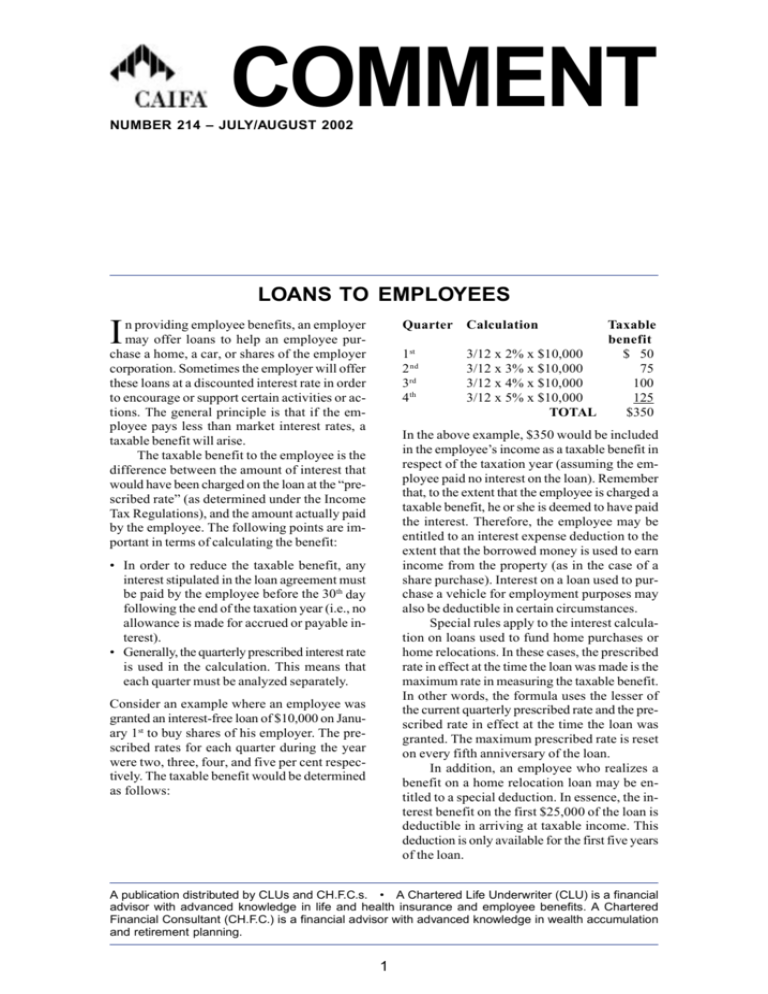
COMMENT
NUMBER 214 – JULY/AUGUST 2002
LOANS TO EMPLOYEES
Quarter
I
n providing employee benefits, an employer
may offer loans to help an employee purchase a home, a car, or shares of the employer
corporation. Sometimes the employer will offer
these loans at a discounted interest rate in order
to encourage or support certain activities or actions. The general principle is that if the employee pays less than market interest rates, a
taxable benefit will arise.
The taxable benefit to the employee is the
difference between the amount of interest that
would have been charged on the loan at the “prescribed rate” (as determined under the Income
Tax Regulations), and the amount actually paid
by the employee. The following points are important in terms of calculating the benefit:
1st
2 nd
3rd
4th
Calculation
Taxable
benefit
3/12 x 2% x $10,000
$ 50
3/12 x 3% x $10,000
75
3/12 x 4% x $10,000
100
3/12 x 5% x $10,000
125
TOTAL
$350
In the above example, $350 would be included
in the employee’s income as a taxable benefit in
respect of the taxation year (assuming the employee paid no interest on the loan). Remember
that, to the extent that the employee is charged a
taxable benefit, he or she is deemed to have paid
the interest. Therefore, the employee may be
entitled to an interest expense deduction to the
extent that the borrowed money is used to earn
income from the property (as in the case of a
share purchase). Interest on a loan used to purchase a vehicle for employment purposes may
also be deductible in certain circumstances.
Special rules apply to the interest calculation on loans used to fund home purchases or
home relocations. In these cases, the prescribed
rate in effect at the time the loan was made is the
maximum rate in measuring the taxable benefit.
In other words, the formula uses the lesser of
the current quarterly prescribed rate and the prescribed rate in effect at the time the loan was
granted. The maximum prescribed rate is reset
on every fifth anniversary of the loan.
In addition, an employee who realizes a
benefit on a home relocation loan may be entitled to a special deduction. In essence, the interest benefit on the first $25,000 of the loan is
deductible in arriving at taxable income. This
deduction is only available for the first five years
of the loan.
• In order to reduce the taxable benefit, any
interest stipulated in the loan agreement must
be paid by the employee before the 30th day
following the end of the taxation year (i.e., no
allowance is made for accrued or payable interest).
• Generally, the quarterly prescribed interest rate
is used in the calculation. This means that
each quarter must be analyzed separately.
Consider an example where an employee was
granted an interest-free loan of $10,000 on January 1st to buy shares of his employer. The prescribed rates for each quarter during the year
were two, three, four, and five per cent respectively. The taxable benefit would be determined
as follows:
A publication distributed by CLUs and CH.F.C.s. • A Chartered Life Underwriter (CLU) is a financial
advisor with advanced knowledge in life and health insurance and employee benefits. A Chartered
Financial Consultant (CH.F.C.) is a financial advisor with advanced knowledge in wealth accumulation
and retirement planning.
1
The prescribed rate on employee and shareholder loans is three per cent for the third quarter of 2002. While this is an increase over the
two per cent rate applicable in the second quarter, the prescribed rate is lower than it has been
for many years. Many types of plans and arrangements are available to individuals who
want to take advantage of this opportunity.
For employees who own 10 per cent or
more of their company shares, separate rules
apply. The full amount of the loan will be included in the individual’s income in the year the
loan is made, unless:
• the loan was granted to the individual because of the employment relationship (rather
than because of the shareholding);
• the loan is for the purpose of buying a home,
unissued shares, or a work-related car; and
• the loan contains bona fide arrangements for
repayment within a reasonable time.
I/R 2400.00, 7401.00
If all of these requirements are met, the taxable
benefit will be calculated as it is for other employees.
RISK MANAGEMENT FOLLOWING
A RELATIONSHIP BREAKDOWN
T
Wilson, Michelle, and Barbara each have to consider the financial impact of the risks that they
face.
he emotional and financial bond that
grows within a family unit is fractured
with the onset of separation and divorce. Dealing with the emotional outcome of a relationship breakdown creates tremendous stress,
which is compounded when the need to separate the financial interdependencies is added into
the equation. It is easy to see how relationship
breakdowns can become fraught with distrust.
Risk management should be an important
consideration in the agreement arising out of a
relationship breakdown. If the agreement requires ongoing spousal or child support, the
death or disability of the supporting spouse (or
common-law partner) could have a direct finanial
impact on the former spouse, a new spouse,
children from the former relationship, and children from a current relationship.
Disability
If any of the adults becomes disabled, the ability
to earn an income could disappear or be substantially impaired. From a planning perspective, it is important to review the financial impact that the disability of one individual could
have on the others:
• If Wilson becomes disabled, his ability to pay
support to Michelle could become restricted
and his ability to support his current family
could also become strained.
• If Michelle becomes disabled, her financial
contribution to her family would be severely
impaired. She may turn to Wilson for additional support. Perhaps a downgrade in
Michelle’s lifestyle, due to financial limitations,
could cause Wilson to be emotionally drawn
into a new level of financial support which
neither he nor his current family anticipated.
• If Barbara becomes disabled, her contribution
to her family could become restricted, which
in turn could impact Wilson’s ability to pay
support to Michelle.
Consider the following example:
• Wilson pays $1,700 in child support and $700
in spousal support per month to his former
spouse, Michelle. Wilson is now married to
Barbara and together they have two young
children.
• Although Michelle works, payments provided
by Wilson are an integral part of her family’s
financial plan. The combination of child and
spousal support represents $28,800 ($20,400
+ $8,400) in annual income for Michelle. Because the child support falls under an agreement made after April 30, 1997, $20,400 is
non-taxable and $8,400 is taxable when received by Michelle.
The purchase of an individual disability income
policy will not eliminate the financial risks associated with a disability, but it can help manage
them.
2
Death
Planning for the death of a spouse or former
spouse has to address a similar combination of
risk factors:
• Barbara’s premature death will impact Wilson
in terms of the financial security of his second
family, and could well impact Wilson’s ability
to maintain support payments to Michelle.
• Wilson’s premature death would result in the
loss of his income contribution to his second
family, along with the loss of support payments to Michelle and the children from his
first family. Michelle may have to make a claim
against Wilson’s estate to secure her family’s
financial position. Parents have a legal responsibility to provide financial support for their
children regardless of whether the parents live
together, are separated, or are divorced. Planning for Wilson’s estate should consider the
long-term financial situation of Barbara and
Wilson’s second family, as well as Wilson’s
financial obligations for his first family.
• The premature death of Michelle would likely
result in Wilson assuming full financial responsibility for his children. Under the current arrangements, the children live with
Michelle and, although Wilson provides child
support payments, Michelle makes a significant contribution to the family’s financial support. The loss of Michelle’s contribution and
the potential shift in custody to Wilson has
significant financial implications.
Life insurance is a critical tool that can eliminate
the risk element for the individuals involved in
such a situation. To ensure that no one is caught
by surprise, it is generally beneficial for each
spouse to own a life insurance policy on the life
of the other spouse. This gives the former
spouses control and security. At the time of separation, Wilson and Michelle could each purchase
a life insurance policy on the life of the other.
While the owner of the policy assumes financial
responsibility for the policy premiums, the
owner also retains control of the beneficiary designation and decisions concerning the policy,
thereby managing the long-term financial risk
associated with a relationship breakdown.
Careful planning should be a primary consideration as individuals move through the stages
toward financial independence following a relationship breakdown. Not only must the immediate financial issues be addressed, but also the
management of any potential risk to the longterm plans.
I/R 2200.00
SMALL BUSINESS DEDUCTION
A
“associated” companies, as defined in the Income Tax Act. In very general terms, two companies are associated if one controls the other,
or if both companies are controlled by the same
individual or group of individuals.
A key piece of the small business deduction is determining the company’s active business income carried on in Canada:
Canadian-controlled private corporation
(“CCPC”) is entitled to a deduction known
as the small business deduction. The deduction
from the company’s federal tax otherwise payable results in a low rate of tax on a company’s
first $200,000 of profit.
The small business deduction is equal to 16 per
cent of the least of the following amounts:
1. the company’s net income from an active business carried on in Canada;
2. the company’s taxable income (in excess of
certain deductions for foreign taxes paid); and
3. the company’s business limit.
• “Carried on in Canada” indicates that any active income from foreign operations will not
count in the calculation.
• “Active business income” has been defined to
mean income other than investment income or
personal services income.
The calculation takes into account the company’s actives business income as well as its taxable income. In this fashion, the deduction is
limited to the active business income portion of
the company’s taxable income.
For federal income tax purposes, a company’s business limit is $200,000. However, a
company must share its business limit with any
Personal services income is colloquially referred
to as the income earned by an incorporated employee. The exclusion of personal services income is intended to prevent highly paid executives from rerouting their income through a corporation in order to have a portion of their income subject to the low corporate tax rate. The
primary exceptions to the rule are situations
3
The small business deduction offers a
tremendous advantage for small businesses
operating in Canada. The government’s policy
objective is to encourage investment in
Canada, and by allowing some business
income to be taxed at a low rate, the business
can retain more of its earnings to finance
expansion.
Small CCPCs also benefit from an
acceleration of the seven per cent general
corporate rate reduction that is being phased
in from 2001 to 2004. The full seven per cent
reduction now applies to active business
income of between $200,000 and $300,000.
Finally, note that most provinces also
offer a lower tax rate on the first $200,000 (or
more) of the active business income of a
CCPC, thus compounding the benefits of the
federal small business deduction.
where there are more than five full-time employees, or where income passes between associated companies.
Some provinces now permit professionals
such as lawyers, accountants, and physicians to
incorporate. Unless the professional is already
an employee of an organization, the active income from the incorporated professional practice would qualify for the small business deduction. This result is not unexpected because a
professional practice is similar to a business
carried on by a sole proprietor or partnership,
which could incorporate.
The factors in the calculation of the small
business deduction would seem to indicate
that every business operating in Canada has
the advantage of a low rate of tax on the first
$200,000 of its income. To prevent large
corporations from accessing this deduction,
the business limit of $200,000 is reduced by a
formula that takes into account a tax on the
capital of large corporations. In this fashion,
large corporations are denied access to the
small business deduction.
I/R 7401.00
Contributors to this issue of Comment:
James W. Kraft, CA, CFP, CLU, CH.F.C. and Deborah Kraft, CFP, CLU, CH.F.C.
This commentary is published by the Canadian Association of Insurance and Financial
Advisors (CAIFA) in consultation with an editorial board comprised of recognized authorities in the fields of law, life insurance and estate administration.
The Canadian Association of Insurance and Financial Advisors (CAIFA) is a voluntary, notfor-profit professional association whose members, gathered in 50 chapters, are represented
in most major cities and towns across Canada.
The articles in Comment are not intended to provide legal, accounting or other advice in
individual circumstances. Seek professional assistance before acting upon information included in this publication.
® Registered trade-mark of Canadian Association of Insurance and Financial Advisors.
Published by:
Copyright 2002
Canadian Association of Insurance and Financial Advisors
350 Bloor Street East, 2nd Floor, Toronto ON M4W 3W8
P:(416) 444-5251 or 1-800-563-5822 • F:(416) 444-8031
www.caifa.com • info@caifa.com
ISSN 0382-7038
4
All Rights Reserved






